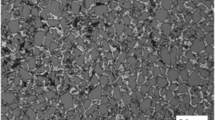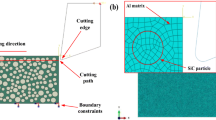Abstract
A multi-phase two-dimension finite element model has been developed by using ABAQUS/Explicit in order to describe the effect of reinforcement particles’ existence in SiCp/Al6063 composites on the machining process. It is used to simulate the high-speed milling process of high volume fraction SiCp/Al6063 composites. As comparison, the same machining process of matrix Al6063 is simulated with the HEM (homogenous equivalent material) model. These two models are verified with quasi-orthogonal slot milling tests. It is assumed that the variation of predicted milling forces with the feed rate is consistent with the experiments and the prediction error of the peak value of F y can be controlled within 10 %. Moreover, multi-phase model is helpful for discovering the miscellaneous interactions of matrix, particle and tool and the induced complicated stress distribution in the cutting area, for further obtaining an in-depth understanding of removal mechanism of SiCp/Al6063 composites.
Similar content being viewed by others
References
Lin JT, Bhattacharyya D, Lane C (1995) Machinability of a silicon carbide reinforced aluminium metal matrix composite. Wear 181:883–888
Wang Z, Chen TK, Lloyd DJ (1993) Stress distribution in particulate-reinforced metal-matrix composites subjected to external load. Metall Trans A 24(1):197–207
El-Gallab M, Sklad M (1998) Machining of Al/SiC particulate metal matrix composites: part II: workpiece surface integrity. J Mater Process Technol 83(1):277–285
Monaghan J, Brazil D (1997) Modeling the sub-surface damage associated with the machining of a particle reinforced MMC. Comput Mater Sci 9(1):99–107
Monaghan J, Brazil D (1998) Modelling the flow processes of a particle reinforced metal matrix composite during machining. Compos A: Appl Sci Manuf 29(1):87–99
Zhu Y, Kishawy HA (2005) Influence of alumina particles on the mechanics of machining metal matrix composites. Int J Mach Tools Manuf 45(4):389–398
Pramanik A, Zhang LC, Arsecularatne JA (2007) An FEM investigation into the behavior of metal matrix composites: tool–particle interaction during orthogonal cutting. Int J Mach Tools Manuf 47(10):1497–1506
Dandekar CR, Shin YC (2009) Multi-step 3-D finite element modeling of subsurface damage in machining particulate reinforced metal matrix composites. Compos A: Appl Sci Manuf 40(8):1231–1239
Zhou L, Huang ST, Wang D, Yu XL (2011) Finite element and experimental studies of the cutting process of SiCp/Al composites with PCD tools. Int J Adv Manuf Technol 52(5–8):619–626
Fathipour M, Zoghipour P, Tarighi J, Yousefi R (2012) Investigation of reinforced SiC particles percentage on machining force of metal matrix composite. Mod Appl Sci 6(8):9–20
Shui XJ, Zhang YD, Wu Q (2014) Mesoscopic model for SiCP/Al composites and simulation on the cutting process. Appl Mech Mater 487:189–194
Umer U, Ashfaq M, Qudeiri JA, Hussein HMA (2015) Modeling machining of particle-reinforced aluminum-based metal matrix composites using cohesive zone elements. Int J Adv Manuf Technol 78:1171–1179
Strenkowski JS, Carroll JT (1985) A finite element model of orthogonal metal cutting. J Eng Ind 107(4):349–354
Lin ZC, Lin SY (1992) A coupled finite element model of thermo-elastic–plastic large deformation for orthogonal cutting. J Eng Mater Technol 114(2):218–226
Komvopoulos K, Erpenbeck SA (1991) Finite element modeling of orthogonal metal cutting. J Eng Ind 113(3):253–267
Zhang L (1999) On the separation criteria in the simulation of orthogonal metal cutting using the finite element method. J Mater Process Technol 89:273–278
Pramanik A, Zhang LC, Arsecularatne JA (2006) Prediction of cutting forces in machining of metal matrix composites. Int J Mach Tools Manuf 46(14):1795–1803
Lloyd DJ (1991) Aspects of fracture in particulate reinforced metal matrix composites. Acta Metall Mater 39(1):59–71
Spowart JE, Miracle DB (2003) The influence of reinforcement morphology on the tensile response of 6061/SiC/25p discontinuously reinforced aluminum. Mater Sci Eng A 357(1):111–123
Zhang H (2001) Plastic deformation and chip formation mechanisms during machining of copper, aluminum and an aluminum matrix composite. Dissertation, North Carolina State University
Author information
Authors and Affiliations
Corresponding author
Rights and permissions
About this article
Cite this article
Wang, B., Xie, L., Chen, X. et al. The milling simulation and experimental research on high volume fraction of SiCp/Al. Int J Adv Manuf Technol 82, 809–816 (2016). https://doi.org/10.1007/s00170-015-7399-1
Received:
Accepted:
Published:
Issue Date:
DOI: https://doi.org/10.1007/s00170-015-7399-1




